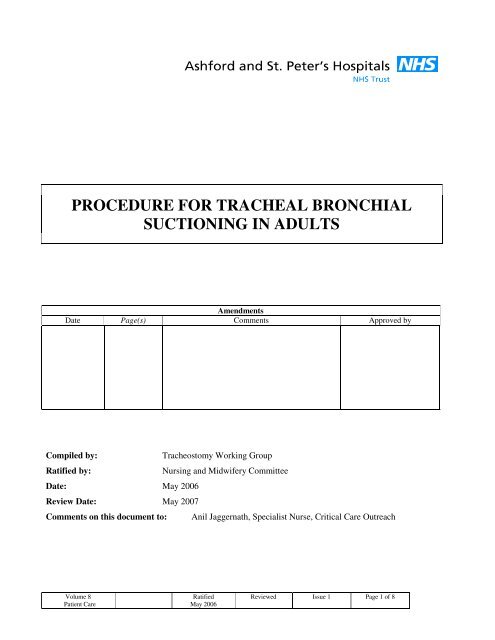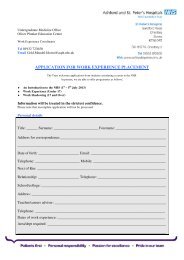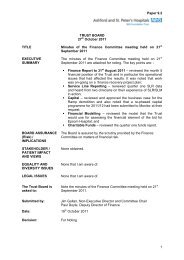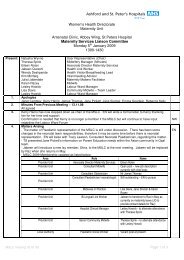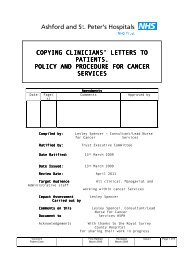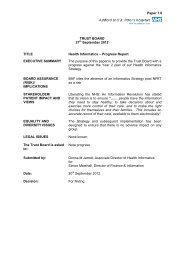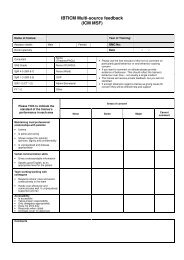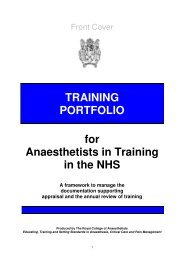Procedure for tracheal bronchial suctioning in adults.pdf
Procedure for tracheal bronchial suctioning in adults.pdf
Procedure for tracheal bronchial suctioning in adults.pdf
Create successful ePaper yourself
Turn your PDF publications into a flip-book with our unique Google optimized e-Paper software.
PROCEDURE FOR TRACHEAL BRONCHIAL<br />
SUCTIONING IN ADULTS<br />
Amendments<br />
Date Page(s) Comments Approved by<br />
Compiled by: Tracheostomy Work<strong>in</strong>g Group<br />
Ratified by: Nurs<strong>in</strong>g and Midwifery Committee<br />
Date: May 2006<br />
Review Date: May 2007<br />
Comments on this document to: Anil Jaggernath, Specialist Nurse, Critical Care Outreach<br />
Volume 8<br />
Patient Care<br />
Ratified<br />
May 2006<br />
Reviewed Issue 1 Page 1 of 8
Volume 8<br />
Patient Care<br />
ASHFORD AND ST PETER’S HOSPITALS NHS TRUST<br />
PROCEDURE FOR TRACHEAL BRONCHIAL SUCTIONING<br />
See also: Tracheostomy care pictorial guide<br />
Tracheostomy care observation chart<br />
Tracheostomy care competency<br />
Tracheostomy Care Plan<br />
<strong>Procedure</strong> <strong>for</strong> removal of <strong>in</strong>ner cannula of a tracheostomy tube<br />
1.0 DEFINITION<br />
Tracheal <strong>bronchial</strong> <strong>suction<strong>in</strong>g</strong> is the removal of sputum via placement of a sterile suction catheter <strong>in</strong>to<br />
a tracheostomy tube us<strong>in</strong>g a sterile non-touch technique.<br />
2.0 AIMS<br />
Tracheal <strong>bronchial</strong> <strong>suction<strong>in</strong>g</strong> aims to effectively remove the maximum amount of secretions with<br />
m<strong>in</strong>imal risk of complications to the patient.<br />
3.0 INDICATIONS FOR PROCEDURE<br />
3.1 A tracheostomy provides a patient with a patent airway. If the patient is unable to clear<br />
secretions from the airway <strong>in</strong>dependently, <strong>suction<strong>in</strong>g</strong> is <strong>in</strong>dicated<br />
3.2 Frequency <strong>for</strong> <strong>tracheal</strong> suction is determ<strong>in</strong>ed by <strong>in</strong>dividual cl<strong>in</strong>ical assessment of patient need<br />
and should not be considered as a rout<strong>in</strong>e procedure. The follow<strong>in</strong>g are recognised <strong>in</strong>dications<br />
<strong>for</strong> <strong>tracheal</strong> suction and <strong>in</strong>clude:-<br />
• Patient request of <strong>in</strong>ability to cough up secretion<br />
• Increased cough<strong>in</strong>g of patient<br />
• Audible secretions <strong>in</strong> chest by listen<strong>in</strong>g or chest auscultation<br />
• Secretions felt on chest by resonance on chest wall<br />
• Increased work of breath<strong>in</strong>g and/ or use of accessory muscles<br />
• Tachypnoea / <strong>in</strong>crease <strong>in</strong> respiratory rate<br />
• Change <strong>in</strong> sk<strong>in</strong> colour or peripheral desaturation <strong>in</strong>dicated by a significant reduction <strong>in</strong><br />
SpO2 from basel<strong>in</strong>e<br />
• Reduction <strong>in</strong> anticipated ventilatory parameter (if patient receiv<strong>in</strong>g non-<strong>in</strong>vasive positive<br />
pressure ventilation)<br />
4.0 EQUIPMENT/ PREPARATION REQUIRED<br />
• Emergency equipment, ambu bag -valve mask, Tracheostomy Emergency Box<br />
• A functional suction unit 13.5 – 20 Kpa (Glass & Graz, 1995 Regan, 1998)<br />
• Correct size sterile catheters (Formula Tracheostomy tube size –2 x2 i.e. size 8 tube : 8 – 2 = 6<br />
x2 = 12)<br />
• Yankeur suction catheter<br />
• Disposable sterile gloves<br />
• Latex universal gloves<br />
• Protective eye wear<br />
• Apron<br />
Ratified<br />
May 2006<br />
Reviewed Issue 1 Page 2 of 8
• 1 bottle of Sterile Water (To be used <strong>for</strong> 24 hours, label with change date and ‘For Suction’)<br />
• Connected oxygen delivery supply (tracheostomy mask and tube if patient on air)<br />
5.0 COMPONENTS OF PROCEDURE<br />
• Preparation of patient and equipment<br />
• Suction<strong>in</strong>g technique<br />
• Evaluation of procedure<br />
6.0 GUIDELINE FOR PROCEDURE<br />
Volume 8<br />
Patient Care<br />
ACTION<br />
Preparation of equipment and patient<br />
Ratified<br />
May 2006<br />
RATIONALE<br />
1. Wash hands with liquid soap or alcohol hand gel To reduce the risk of cross-<strong>in</strong>fection<br />
and put on apron.<br />
(Rossoff et al, 1993).<br />
2. Expla<strong>in</strong> procedure to patient. To ga<strong>in</strong> consent, allay any fears and<br />
enable the patient to co-operate.<br />
3. Apply protective eye goggles (to be worn<br />
throughout the suction procedure).<br />
4. Remove <strong>in</strong>ner cannula and replace with clean<br />
<strong>in</strong>ner cannula.<br />
5. Consider pre-oxygenation of patient prior to<br />
procedure.<br />
Indicated if previous evidence of <strong>in</strong>creased work<br />
of breath<strong>in</strong>g, <strong>in</strong>dicators of respiratory distress,<br />
tachypnoea and deoxygenation dur<strong>in</strong>g or after<br />
previous <strong>suction<strong>in</strong>g</strong> procedures.<br />
Pre-oxygenation procedure:<br />
Increase the <strong>in</strong>spired oxygen concentration by<br />
50% to the patient three m<strong>in</strong>utes prior to<br />
procedure.<br />
NB: For Chronic Obstructive Pulmonary<br />
Disease (COPD) patients; <strong>in</strong>crease the <strong>in</strong>spired<br />
oxygen with 20% only (Rogge, 1989)<br />
6. Select the appropriate size suction catheter <strong>for</strong><br />
patient need.<br />
To calculate correct catheter size<br />
• Subtract 2 from the size of the<br />
tracheostomy tube<br />
• Multiply by 2<br />
(Caroll, 1994).<br />
To reduce the risk of cross <strong>in</strong>fection from<br />
the patient’s secretions.<br />
To avoid passage of potential sputum plug<br />
<strong>in</strong>to patient on <strong>suction<strong>in</strong>g</strong>.<br />
To reduce the risk of arrhythmia and<br />
hypoxia (Odell et al, 1993).<br />
COPD patients have an altered serum<br />
carbon dioxide response mechanism and<br />
have a dependent on carbon dioxide<br />
levels to ma<strong>in</strong>ta<strong>in</strong> their respiratory drive.<br />
Catheter size should be less than half the<br />
<strong>tracheal</strong> diameter (Young, 1984).<br />
The lowest possible pressure should be<br />
used to reduce complications (Regan,<br />
1998).<br />
Reviewed Issue 1 Page 3 of 8
Volume 8<br />
Patient Care<br />
ACTION<br />
7. Connect suction catheter to suction unit and<br />
check function of suction system.<br />
• Turn on the suction apparatus.<br />
• Attach suitably sized suction catheter end to<br />
suction tub<strong>in</strong>g.<br />
• Ensure that catheter is not removed from<br />
packag<strong>in</strong>g.<br />
• Check that connection is secure. K<strong>in</strong>k<br />
suction tub<strong>in</strong>g and observe pressure on<br />
gauge.<br />
• Adjust pressure flow to achieve a vacuum<br />
pressure between 13.5-20kPa (Glass & Grap,<br />
1995)<br />
Suction<strong>in</strong>g technique<br />
8. Put on sterile glove on dom<strong>in</strong>ant hand. Avoid<br />
touch<strong>in</strong>g anyth<strong>in</strong>g except the catheter with it.<br />
9. Remove suction catheter from cover<strong>in</strong>g ensur<strong>in</strong>g<br />
that the dom<strong>in</strong>ant hand with sterile glove only<br />
touches the suction catheter. Avoid touch<strong>in</strong>g<br />
anyth<strong>in</strong>g else but the suction catheter.<br />
10. Hold end of suction catheter with dom<strong>in</strong>ant<br />
sterile hand and use other hand to hold the<br />
suction catheter connection site with thumb<br />
accessible to suction port.<br />
11. With suction port uncovered with thumb,<br />
<strong>in</strong>troduce the end suction catheter gently down<br />
tracheostomy tube to a depth of one third of<br />
tracheostomy length (or until length of suction<br />
catheter is at approximately 15 cm mark) or<br />
until patient coughs or resistance felt, then<br />
withdraw approximately 1 cm (Meyer-<br />
Holloway, 1993) be<strong>for</strong>e apply<strong>in</strong>g suction by<br />
plac<strong>in</strong>g thumb over suction port.<br />
12. Apply suction and withdraw the suction catheter<br />
slowly ma<strong>in</strong>ta<strong>in</strong><strong>in</strong>g cont<strong>in</strong>uous suction. Avoid<br />
rotation of catheter or <strong>in</strong>termittent <strong>suction<strong>in</strong>g</strong>.<br />
• Do not suction <strong>for</strong> more than 10-15<br />
seconds Fiorent<strong>in</strong>i,1992; Czarnik RE<br />
et al,1991).<br />
Whilst withdraw<strong>in</strong>g suction catheter observe<br />
patient <strong>for</strong> signs of complications. Signs<br />
<strong>in</strong>clude:-<br />
• Reduced level of consciousness<br />
• Pale and clamm<strong>in</strong>ess<br />
Ratified<br />
May 2006<br />
RATIONALE<br />
Check that the suction apparatus is<br />
function<strong>in</strong>g and that the vacuum pressure<br />
is set between 13 – 20kpa.<br />
To avoid contam<strong>in</strong>ation and reduce risk of<br />
cross-<strong>in</strong>fection.<br />
To avoid contam<strong>in</strong>ation and reduce risk of<br />
cross-<strong>in</strong>fection.<br />
To enable easy access to pass<strong>in</strong>g the<br />
suction catheter.<br />
To prevent trauma and mucosal damage<br />
by the suction catheter contact on mucosa<br />
on <strong>in</strong>sertion.<br />
To ensure suction catheter does not pass<br />
the car<strong>in</strong>a.<br />
To ensure the most effective clearance of<br />
secretions.<br />
To avoid patient develop<strong>in</strong>g hypoxaemia<br />
due to removal of oxygen flow by suction.<br />
To detect complications of hypoxaemia<br />
and cardiac arrhythmias.<br />
Reviewed Issue 1 Page 4 of 8
Suction<strong>in</strong>g technique<br />
Volume 8<br />
Patient Care<br />
• Peripheral cyanosis<br />
• Excess cough<strong>in</strong>g<br />
Withdraw suction catheter immediately and<br />
cl<strong>in</strong>ically assess patient.<br />
13. When the suction catheter is completely<br />
removed from the tracheostomy tube, release the<br />
thumb from suction port. Wrap the suction<br />
catheter around dom<strong>in</strong>ant hand, enclose <strong>in</strong> glove<br />
and discard.<br />
14. Re-apply the patient’s oxygen supply<br />
immediately.<br />
15. R<strong>in</strong>se suction tub<strong>in</strong>g through with water from<br />
bottle.<br />
16. Change suction tub<strong>in</strong>g once a week or when<br />
heavily soiled.<br />
Evaluation of procedure<br />
17. Cl<strong>in</strong>ically assess patient <strong>for</strong> need <strong>for</strong> further<br />
<strong>suction<strong>in</strong>g</strong>.<br />
18. Repeat above with new suction catheter &<br />
gloves until airway clear.<br />
NB: Allow sufficient time <strong>for</strong> recovery between<br />
each suction episode (particularly if the patient<br />
is <strong>in</strong> respiratory distress or if there are<br />
<strong>in</strong>dication of a reduction of peripheral<br />
oxygenation dur<strong>in</strong>g procedure). The number<br />
of <strong>suction<strong>in</strong>g</strong> procedures should be limited to<br />
three each episode.<br />
19. Observe and document volume, consistency and<br />
colour on tracheostomy care observation chart.<br />
7.0 TROUBLESHOOTING COMPLICATIONS<br />
Ratified<br />
May 2006<br />
To reduce cross <strong>in</strong>fection.<br />
To reduce risk of further hypoxaemia.<br />
To prevent blockage of suction tub<strong>in</strong>g and<br />
prevent cross-<strong>in</strong>fection.<br />
To reduce risk of <strong>in</strong>fection.<br />
To determ<strong>in</strong>e need <strong>for</strong> further <strong>suction<strong>in</strong>g</strong>.<br />
To enable time <strong>for</strong> patient to recover from<br />
trauma of procedure and to prevent<br />
exhaustion and distress <strong>for</strong> patient.<br />
To m<strong>in</strong>imize potential complications.<br />
To enable detection of chest <strong>in</strong>fection and<br />
care needs.<br />
Reviewed Issue 1 Page 5 of 8
Volume 8<br />
Patient Care<br />
Complication Action Rationale<br />
7.1 Respiratory distress • Withdraw suction catheter.<br />
• Monitor vital signs.<br />
• Consider supplementary oxygen.<br />
• Seek medical advice if<br />
7.2 Reduction <strong>in</strong> level of<br />
consciousness<br />
8. REFERENCES AND BIBLIOGRAPHY<br />
respiratory distress cont<strong>in</strong>ues.<br />
• Withdraw suction catheter<br />
immediate.<br />
• Assess airway.<br />
• Adm<strong>in</strong>ister 100% oxygen.<br />
• Call <strong>for</strong> help.<br />
7.3 Blood sta<strong>in</strong>ed sputum • Report to medical staff.<br />
• Ensure correct sized suction<br />
catheter used.<br />
• Avoid <strong>in</strong>sertion of catheter until<br />
resistance felt estimate<br />
approximate level of <strong>in</strong>sertion of<br />
suction catheter.<br />
• Ensure suction pressures used<br />
are 13.5-20Kpa.<br />
• Ensure once suction catheter is<br />
<strong>in</strong>serted <strong>in</strong>to tracheostomy it is<br />
kept mov<strong>in</strong>g when suction<br />
7.4 Tenacious Sputum –<br />
m<strong>in</strong>imal amount on<br />
suction<br />
applied.<br />
• Consider use of humidification<br />
• Adjust suction pressure to<br />
maximum of 20kpa<br />
• Take a sample of sputum <strong>for</strong><br />
culture and sensitivity<br />
• In<strong>for</strong>m medical staff<br />
Complication Action Rationale<br />
7.5 Suspected occlusion<br />
or resistance <strong>in</strong> <strong>in</strong>ner<br />
cannula<br />
• Immediately withdraw suction<br />
catheter.<br />
• Remove <strong>in</strong>ner cannula and<br />
<strong>in</strong>spect.<br />
• Replace with new <strong>in</strong>ner cannula.<br />
• Seek medical advice.<br />
• If patient exhibits signs of<br />
respiratory distress per<strong>for</strong>m<br />
procedure <strong>for</strong> suspected blocked<br />
tracheostomy tube.<br />
Carroll PF (1993) Safe suction PRN Registered Nurse, 57,5,32-37.<br />
Ratified<br />
May 2006<br />
To avoid hypoxaemia.<br />
To avoid trauma to the<br />
bifurcation of the trachea.<br />
To prevent <strong>in</strong>vag<strong>in</strong>ation of<br />
the mucosa through the<br />
catheter end and hole.<br />
To prevent blockage of<br />
tube and subsequent<br />
respiratory arrest.<br />
Reviewed Issue 1 Page 6 of 8
Czarnik RE, Stone KS, Everhart CC, Preusser BA (1991,20,2,144-151.<br />
Fluck RR (1985) Suction<strong>in</strong>g – Intermittent or cont<strong>in</strong>uous? Respiratory Care, 30,837-838<br />
Fiorent<strong>in</strong>i A. (1992) Potential hazards of tracheo<strong>bronchial</strong> <strong>suction<strong>in</strong>g</strong> Intensive Care and Critical care<br />
nurs<strong>in</strong>g,8,217-226.<br />
Glass CA, Grap MJ (1995) Ten tips <strong>for</strong> safer <strong>suction<strong>in</strong>g</strong> Advanced Journal of Nurs<strong>in</strong>g, 5,51-53.<br />
Meyer-Holloway N. (1993) Nurs<strong>in</strong>g <strong>in</strong> the Critically Ill Adult, 4 th edition. Cali<strong>for</strong>nia, Addison-Wesley<br />
Odell A, Allder A, Bayne R, Everatt C, Scott S, Still B, West S. (1993) Endo<strong>tracheal</strong> suction of adult,<br />
non-head <strong>in</strong>jured patients: A review of the literature Intensive Care and Critical Care Nurs<strong>in</strong>g, 9,274-<br />
278.<br />
Regan M (1988) Tracheal mucosal <strong>in</strong>jury – the nurses role Nurs<strong>in</strong>g, 29, 1064-1066<br />
St George’s Healthcare NHS Trust (2000) Guidel<strong>in</strong>es <strong>for</strong> the Care of Patients with Tracheostomy<br />
Tubes. London: St. George’s NHS Trust, 2000.<br />
Young CS (1984) Recommended guidel<strong>in</strong>es <strong>for</strong> suction Physiotherapy,3,106-107.<br />
Volume 8<br />
Patient Care<br />
Ratified<br />
May 2006<br />
Reviewed Issue 1 Page 7 of 8


